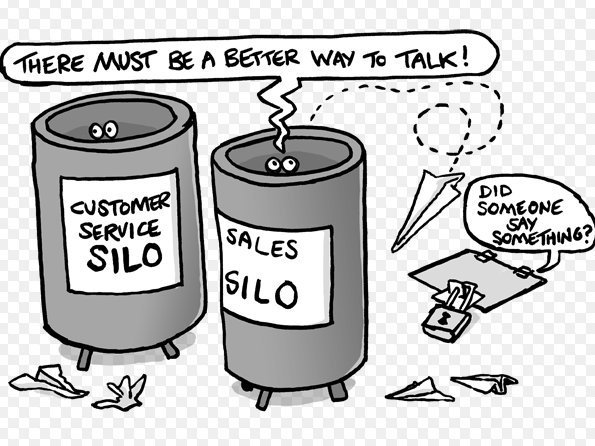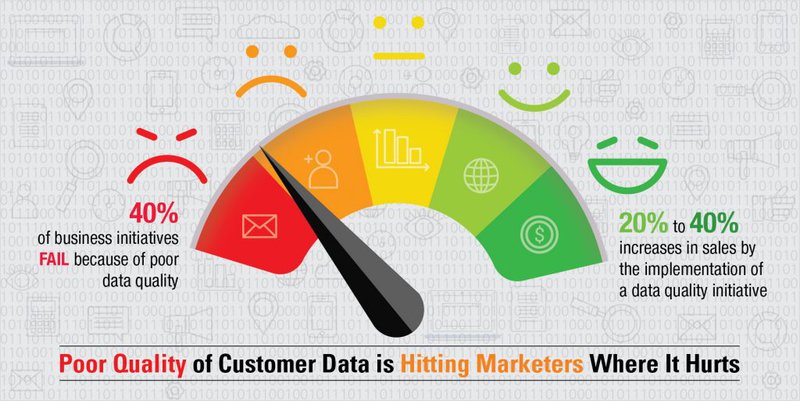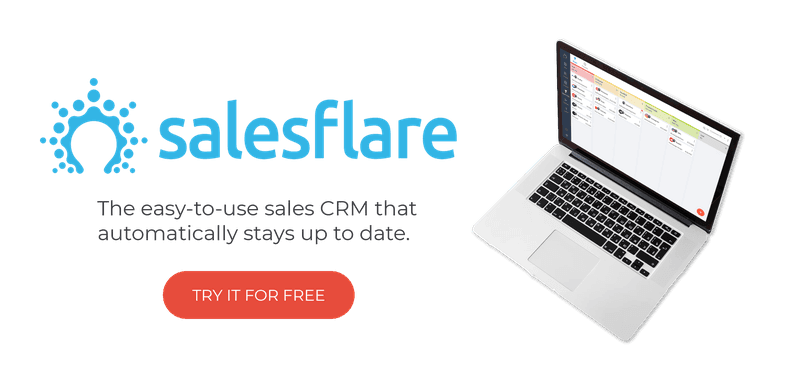Why You Need A Data-Driven Sales Team—And How To Build One
Un blog invitado de Josh Brown (Marketing en Helpjuice)

We’re just gonna come right out and say it:
Las ventas son un juego de números.
Hold on, hold on… we don’t mean that in the traditional sense.
(In fact, we’d argue that a wide net, “spray and pray” approach to sales definitely isn’t the way to go by today’s standards.)

What we mean is that, if your goal is to maximize your sales productivity, your first step should be to look to the numbers. This means the myriad data available to your team regarding your customers, your team’s performance, and more.
Tu siguiente paso: lánzate de cabeza.
1. Definición del equipo de ventas basado en datos
Before we get too far ahead of ourselves, we need to nail down exactly what it means for a sales team to be “data-driven.”
Let’s start with a more overarching (and admittedly vague) definition:
Un equipo de ventas basado en datos es aquel que ha integrado el análisis y el uso de datos en todos y cada uno de los procesos y actividades relacionados con las ventas.
As you might imagine, organizations that have become truly data-driven typically outperform their competition—by a pretty wide margin, too. High-performing sales teams are 3.5 times more likely to have used a data-driven approach than their under-performing counterparts. And companies that have “injected” data into their daily operations are 5% more productive and 6% more profitable than their competition.
Now, there are a few key words we want to call attention to: “integrated” and “injected.” That is, truly data-driven sales teams don’t just “use” data: they find ways to “integrate” and “inject” the data into their daily activities through data transformation. Essentially they put data at the center of everything they do. For such teams, data and hard evidence is never an afterthought. In fact, it’s more often the catalyst that leads the team to make a certain decision or take a specific action.
In this article, we’ll discuss everything that needs to happen for your sales team to become truly data-driven in its everyday operations.
Before we dig in, though, let’s talk about some of the more specific benefits of becoming data-driven.
2. Tres ventajas clave de centrarse en los datos
Como acabamos de mencionar, los equipos de ventas basados en datos son más productivos y rentables que sus competidores, que obtienen peores resultados.
Pero estos son realmente los productos secundarios de centrarse en los datos. No se es más productivo y eficiente por el mero hecho de centrarse en los datos, sino por lo que este proceso permite hacer.

Let’s dig a bit deeper into that, shall we?
1. Permite estandarizar (y optimizar) los procesos de venta
En pocas palabras:
Most sales teams and organizations end up wasting a ton of time, money, and energy, because they haven’t truly optimized their various processes.
For starters, sales teams waste a lot of time doing “legwork” rather than actually being productive.

As the image above shows, nearly one-fifth of the average salesperson’s day is spent searching for pertinent information. Not “putting collected data to use”; just searching for it in the first place.
As we’ll get to a bit later on, one of the first steps to becoming data-driven is creating a central data hub that your sales team (and other employees) can access as needed. The easier it is to find the information they need, the quicker your sales team will be able to get to work.
Another issue that comes along with not being data-driven is that you run the risk of wasting resources without even realizing you’re doing so.
Por ejemplo, Altify descubrió que se pierden la asombrosa cantidad de $591 mil millones en EE.UU. (y $1,4 trillones perdidos en todo el mundo) por los equipos de ventas que persiguen clientes potenciales poco brillantes que acaban yendo a ninguna parte. Esto concuerda con los datos recogidos por MarketingSherpa, que muestran que sólo 27% de los clientes potenciales que pasan a ventas son realmente clientes potenciales cualificados.
In such cases, it’s clear that the marketing team’s qualification process differs wildly from the sales team’s processes. Chances are, the data each team is looking at throughout these processes differs just as wildly. Because of this discrepancy, it would simply be impossible for each team to get on the same page moving forward.
However, by centralizing all incoming data (for example, through the use of a CRM)—and collaborating to determine which pieces of information are most vital to a given process—your marketing and sales (and other) teams can begin creating a more systematic approach to creating a funnel that sells.
2. Permite que su equipo de ventas se personalice
En lo que respecta a la atención al cliente, una mayor orientación a los datos también facilita que su equipo de ventas interactúe con clientes potenciales y clientes a un nivel más individual.
Como probablemente sepas, esta personalización es cada vez más demandada hoy en día. Según datos recogidos por Evergage:
- 63% de los consumidores valoran positivamente las marcas que ofrecen ofertas y contenidos personalizados y relevantes
- 77% de los consumidores eligen, recomiendan y pagan más por las marcas que ofrecen un servicio más personalizado
- 78% sólo se interesan por ofertas adaptadas a sus necesidades, basadas en su historial con una marca.
For our purposes, here’s the big one: Most consumers are perfectly fine with companies using their private and public data in order to provide them a more personalized experience.
Needless to say, the more data you collect on your prospects and customers—and the more focused you become on what this data actually “means”—the easier it will be for your sales team to engage with them and nurture them toward conversion.
Along with this, a comprehensive collection and understanding of data can take the guesswork out of approaching relatively unknown prospects. For example, in recognizing similarities between a new prospect and your most-valuable customer segment (in terms of persona, behavior, etc.), you’d know exactly what to do at a given point in time in order to get them to convert.
For a prime example of all this in action, look no further than easyJet’s 20th anniversary campaign. Essentially, the travel company used individual customer data, along with automation software, to develop a dynamic email campaign showcasing each customer’s experience with their brand.

The results were nothing short of outstanding. First of all, the team created and sent out over twelve million unique emails—and saw a massive 100% increase in open rates throughout the campaign. What’s more, the campaign earned a 25% higher click-through rate than easyJet’s typical average.
So…yeah. If your goal is to provide a more personalized experience to your audience, your first step should be to go to the data.
3. Descubre grandes oportunidades
Anteriormente, hemos hablado de cómo basarse en los datos permite reconocer y alejarse de las pistas sin salida y similares.
The other side of all this is that you’ll in turn uncover and recognize a treasure trove of opportunities you may have otherwise overlooked.
Una vez más, todo se reduce a la personalización, y a ofrecer exactamente lo que un consumidor específico quiere en justo el momento adecuado. Algunos ejemplos:
- Saber exactamente qué producto o productos serían valiosos para un nuevo cliente potencial
- Proporcionar ofertas de ventas adicionales y ventas cruzadas a los clientes en función de sus compras actuales y anteriores.
- Envío oportuno de recordatorios y ofertas adicionales a los clientes recurrentes antes de su momento medio de compra.
In each of these scenarios, data is at the center of the sales team’s ability to follow through.
Sin una gran atención a los datos, el equipo podría:
- Lose sales by showcasing products that aren’t best-fit for specific prospects
- Perder ingresos adicionales por pasar por alto las oportunidades de venta cruzada y de incremento de ventas.
- Arriesgarse a perder clientes recurrentes dejando su retorno al azar
Obviamente, querrá evitar estas situaciones en la medida de lo posible. Si te centras en los datos, tu equipo de ventas tendrá claras todas las oportunidades.
A fin de cuentas, basarse más en los datos es bueno para el negocio:
- La racionalización de los procesos garantiza la máxima eficacia y aprovechamiento de los recursos
- Las interacciones personalizadas aumentan las conversiones
- La mayor visibilidad de los datos arroja luz sobre las principales oportunidades de venta
Ahora que sabemos todo esto, la pregunta es:
¿Cómo podemos centrarnos más en los datos dentro de nuestras propias organizaciones?
3. Crear un equipo de ventas basado en datos
As we made clear earlier, there’s a huge difference between merely collecting and using data in a more surface-level manner, and truly integrating data into your overall operations and processes.
Here, we’ll dive into all that goes into creating a sales team (and overall organization) that is truly driven by data.
Without further ado, let’s dive in.
1. Facilitar un cambio cultural y organizativo
If your team isn’t on board with the shift, it’s simply not going to happen.
Hay una serie de cosas que debe hacer para generar esta aceptación entre su equipo de ventas.
First, it’s essential that you frame this discussion in terms of what it means for them. As we talked about earlier, this is all about becoming more productive and efficient—and overall more successful in their efforts as salespeople.
On that same token, it’s also important that you explain why becoming more data-driven will allow your sales team to become more successful. Tap into some of the frustrations your team likely has revolving around data (or lack thereof), such as miscommunication, down time, and wasted opportunities—and show your sales team exactly how a focus on data will help alleviate these pain points moving forward.
Finally, in terms of cultural shift, you’ll want your team to begin operating with a “data first” mindset. That is, your sales team should begin looking to data to inform the next decision they make—not to retroactively rationalize decisions that have already been made. While this might sound like mere semantics, the reality is that taking a “data first” approach to sales will all but ensure your sales team focuses on making improvements that actually matter.
Now, in addition to the cultural and mental shift that must occur throughout your sales team, you’ll also likely need to facilitate a shift in how your sales team interacts with your organization’s other departments.

First, you need to be sure cross-team communication and collaboration is possible, let alone practical. Obviously, if it’s too difficult—or actually impossible—for your sales team to communicate with your marketing and other departments, it’s just not going to happen.
Once cross-team communication is possible throughout your organization, you need to ensure it actually happens—and is done so correctly. Basically, this means systematizing what data and information certain teams are responsible for communicating to whom at certain points in the sales funnel.
We’ll get more into this in a bit, but for now just know that the better your sales and marketing teams communicate, the more aligned they’ll become. By focusing on and communicating the data and information that really makes a difference, each team will gain a more consistent understanding of what a “qualified lead” really is. In turn, your sales team will be able to nurture these high-probability candidates through the sales funnel with relative ease.

Pero, de nuevo, nada de esto es posible a menos que facilite el cambio en toda su organización.
2. Define and Prioritize “Quality” Data
We’ve danced around this topic throughout this article, but let’s lay it right out there:
Part of being truly data-driven is knowing that some data is simply more valuable than other pieces of information. In that same vein, it’s also in knowing how to discern a so-called “vanity metric” from a metric that truly matters to your company’s bottom line in some way or another.
Of course, if you don’t have a specific definition or criteria for what your team considers “quality data,” you’re going to run into problems pretty quickly. As we alluded to earlier, if your marketing team is passing through leads based on one set of data, and your sales team is looking at something completely different, there’s little chance that those prospects will end up converting.

Como se ha mostrado anteriormente, una falta de enfoque en la calidad de los datos puede ser la razón por la que una empresa cierre definitivamente. Por otro lado, las empresas que se centran en la calidad de los datos tienden a experimentar un importante crecimiento de las ventas.
A nuestros efectos, hay dos tipos generales de datos en los que centrarnos:
- Datos relativos a los clientes
- Datos sobre el rendimiento de empleados y equipos
In terms of customer-related data, we’re talking about segmentation and persona information, combined with a specific customer’s individual history with your company.
To be sure, each piece of information you collect on a given customer is important in some way or another. However, it’s important to explicitly define and prioritize specific data to be used at given points in time for sales-related purposes. Not only will it ensure consistency between your marketing and sales teams, but it will also ensure your sales team has exactly what they need to make an informed decision regarding a specific prospect.
In defining these data points, you’ll want to consider a variety of questions such as:
- ¿Qué datos recopila el equipo de marketing que el equipo de ventas necesita conocer?
- A la hora de puntuar a los clientes potenciales, ¿a qué información hay que dar más importancia?
- How will having x piece of data affect the sales team’s approach?
We’ve said it before:
Cuanto más alineados estén sus distintos equipos en lo que respecta al uso de datos, más productivo será su equipo de ventas.
Speaking of that, the other side of defining “quality” data is in looking at the performance of your sales team overall.
Again, our focus here is on the metrics that truly make a difference to the overall productivity and efficiency of your business. More specifically, we’re looking at data points such as:
- Tasa de conversión de clientes potenciales: Obviously, a salesperson’s job is to make sales. If their overall conversion rate is relatively low, you’ll need to dig deeper to determine where the leak occurs, and what the problem actually is.
- Duración del ciclo de ventas: En pocas palabras, cuanto más tiempo tarde su equipo en realizar una venta, menos tiempo tendrá para centrarse en hacer ventas. otros sales. Similarly to the above, it’s important to get granular in determining what, exactly, needs to be improved to shorten an all-too-lengthy sales cycle.
- Valor medio de los pedidos: The probably goes without saying, but the more your sales team can sell at a single time, the better off your business will be. Digging into changes in AOV and other related metrics will give you better insight into what, specifically, presses your target customers’ buying button.
Again, this isn’t to say these are the only metrics that matter; far from it, in fact. The point is that you need to define the metrics that tell a more overarching story about a certain aspect of your business, then dig deeper to decipher the details. The more granular you get, the more information you’ll have on-hand to make improvements in the future.
Puede realizar un seguimiento de estas métricas exactas y más utilizando un CRM como Salesflare. Echa un vistazo a nuestro tour de productos para más información.
3. Integrar herramientas y tecnología
Hey, you didn’t think you’d be tracking all this data by hand, did you?
Bromas aparte, la tecnología es esencialmente la base de su capacidad para recopilar y utilizar toda esta información en primer lugar.
While there are, of course, a plethora of tools and software to choose from to serve your data-driven needs, you’ll at least want to invest in the following:
- Raspadores de datos de clientescomo Datanyze Insiderle permiten recopilar rápidamente información de clientes de varias bases de datos con facilidad. A continuación, puede analizar la lista recopilada en función de criterios específicos para seguir investigando a los clientes.
- Software de gestión de relaciones con los clientes como Salesflare make it easy to keep track of customer profiles and track engagements with prospects throughout their personal buyer’s journey. The more information collected and stored within your CRM, the more personalized your sales team’s approach can be.
- Bases de conocimiento como Helpjuice le permiten crear, almacenar y compartir información importante sobre procesos, productos y otros datos internos. También puede crear bases de conocimientos orientadas al clienteDe este modo, sus clientes se comprometerán más con su empresa y obtendrán más valor de sus productos.
- Seguimiento del rendimiento de las ventas como Ambition facilitan a su equipo la evaluación de la eficacia de sus procesos de ventas tanto a nivel macroeconómico como microeconómico. A su vez, tu equipo puede centrarse en realizar mejoras específicas que les permitan operar con mayor eficacia.
- CDPs or DMPs – other software like a CDP or DMP might also be useful to you. These tools will enable your sales team to have a complete 360 view of customers across all the touch points your business has.
The “best” software for your company depends on your company’s current needs, bandwidth, and other such factors. Before you commit to using any one specific tool or service, make sure you’ve found the one that will integrate most seamlessly into your operations, and that will provide the most value in return.
4. Realizar mejoras continuas
As you can probably tell, shifting toward becoming more data-driven isn’t something that will happen to your sales team overnight.
And, in a sense, it’s not something that ever fully “happens,” at all. That is, there will always be ways for your team to become more data-driven, and to become more efficient and effective in their overall processes, as well.
La buena noticia es:
Cuanto más centrado esté en los datos, más fácil le resultará centrarse aún más en ellos.
For one thing, once your sales team begins to see the positive impact of becoming more data-driven, they’ll inherently want to dive deeper into this “new way” of doing things. Soon enough, your sales team will begin seeing this “new way” will as the normal and natural mode of operating.
Con esta mayor implicación de su equipo de ventas, la realización de mejoras continuas se convertirá esencialmente en parte del proceso, en general. El equipo de ventas realmente orientado a los datos no solo comprende la importancia de inyectar e integrar datos en sus procesos, sino que también empieza a pensar de forma crítica sobre la mejor forma de hacerlo.
As you look to make improvements, you’ll want to think about the answers to questions such as:
- Cómo nos ha permitido mejorar en xyz área el basarnos más en los datos?
- Qué datos hemos determinado que son más esenciales o informativos para mejorar en xyz área?
- Qué otros datos o percepciones podríamos utilizar para seguir mejorando en xyz área?
Por supuesto, estas preguntas no son más que puntos de partida para ayudar a su equipo a profundizar en un proceso o área específicos. Huelga decir que la línea de investigación variará mucho en función del área de interés.
Regardless of your focus, though, with data at the heart of your inquiry, you’ll easily be able to dig up the information needed to make your next steps crystal clear.
Un poco sobre Josh:
Josh Brown forma parte del equipo de marketing de Helpjuice. Helpjuice proporciona bases de conocimiento fáciles de usar y totalmente personalizables, diseñadas desde cero para ayudarle a ampliar su servicio de atención al cliente y colaborar mejor con su equipo.

Esperamos que te haya gustado este post. Si es así, ¡difúndelo!
👉 Puede seguir a @salesflare en Twitter, Facebook y LinkedIn.
if(window.strchfSettings === undefined) window.strchfSettings = {}; window.strchfSettings.stats = {url: “https://salesflare.storychief.io/data-driven-sales-team?id=1549749501&type=2”,title: “Why You Need A Data-Driven Sales Team—And How To Build One”,id: “b4bf56dd-9b24-4318-a472-b8522fe85e05”}; (function(d, s, id) { var js, sjs = d.getElementsByTagName(s)[0]; if (d.getElementById(id)) {window.strchf.update(); return;} js = d.createElement(s); js.id = id; js.src = “https://d37oebn0w9ir6a.cloudfront.net/scripts/v0/strchf.js”; js.async = true; sjs.parentNode.insertBefore(js, sjs); }(document, ‘script’, ‘storychief-jssdk’))- Arréglalo rápido - 3 de abril de 2024
- Guarda tus correos - 21 de diciembre de 2023
- Rastrear cualquier relación - 1 de diciembre de 2023
